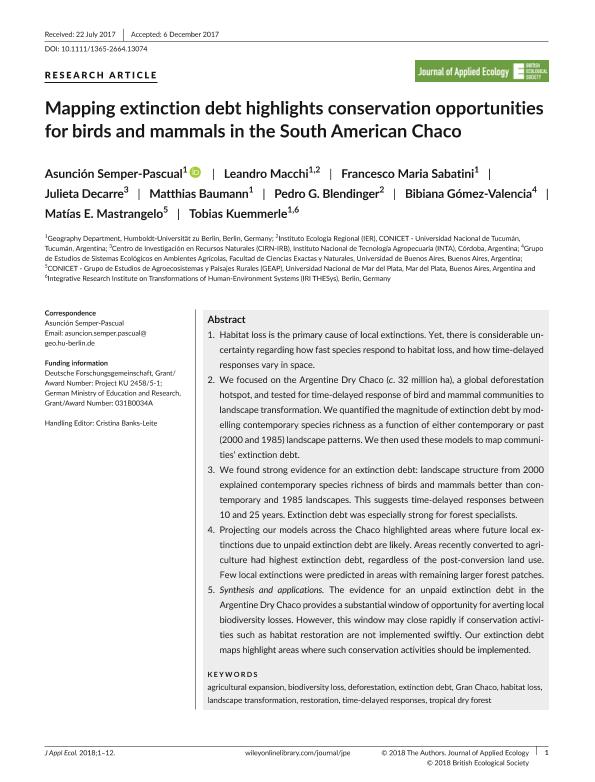Mostrar el registro sencillo del ítem
dc.contributor.author
Semper Pascual, Asunción

dc.contributor.author
Macchi, Leandro

dc.contributor.author
Sabatini, Francesco Maria
dc.contributor.author
Decarre, Julieta

dc.contributor.author
Baumann, Matthias

dc.contributor.author
Blendinger, Pedro Gerardo

dc.contributor.author
Gomez Valencia, Bibiana

dc.contributor.author
Mastrangelo, Matias Enrique

dc.contributor.author
Kuemmerle, Tobias

dc.date.available
2019-11-25T23:45:31Z
dc.date.issued
2018-05
dc.identifier.citation
Semper Pascual, Asunción; Macchi, Leandro; Sabatini, Francesco Maria; Decarre, Julieta; Baumann, Matthias; et al.; Mapping extinction debt highlights conservation opportunities for birds and mammals in the South American Chaco; Wiley Blackwell Publishing, Inc; Journal of Applied Ecology; 55; 3; 5-2018; 1218-1229
dc.identifier.issn
0021-8901
dc.identifier.uri
http://hdl.handle.net/11336/90422
dc.description.abstract
Habitat loss is the primary cause of local extinctions. Yet, there is considerable uncertainty regarding how fast species respond to habitat loss, and how time-delayed responses vary in space. We focused on the Argentine Dry Chaco (c. 32 million ha), a global deforestation hotspot, and tested for time-delayed response of bird and mammal communities to landscape transformation. We quantified the magnitude of extinction debt by modelling contemporary species richness as a function of either contemporary or past (2000 and 1985) landscape patterns. We then used these models to map communities' extinction debt. We found strong evidence for an extinction debt: landscape structure from 2000 explained contemporary species richness of birds and mammals better than contemporary and 1985 landscapes. This suggests time-delayed responses between 10 and 25 years. Extinction debt was especially strong for forest specialists. Projecting our models across the Chaco highlighted areas where future local extinctions due to unpaid extinction debt are likely. Areas recently converted to agriculture had highest extinction debt, regardless of the post-conversion land use. Few local extinctions were predicted in areas with remaining larger forest patches. Synthesis and applications. The evidence for an unpaid extinction debt in the Argentine Dry Chaco provides a substantial window of opportunity for averting local biodiversity losses. However, this window may close rapidly if conservation activities such as habitat restoration are not implemented swiftly. Our extinction debt maps highlight areas where such conservation activities should be implemented.
dc.format
application/pdf
dc.language.iso
eng
dc.publisher
Wiley Blackwell Publishing, Inc

dc.rights
info:eu-repo/semantics/openAccess
dc.rights
Atribución-NoComercial-CompartirIgual 2.5 Argentina (CC BY-NC-SA 2.5 AR)
dc.rights.uri
https://creativecommons.org/licenses/by-nc-sa/2.5/ar/
dc.subject
AGRICULTURAL EXPANSION
dc.subject
BIODIVERSITY LOSS
dc.subject
DEFORESTATION
dc.subject
EXTINCTION DEBT
dc.subject
GRAN CHACO
dc.subject
HABITAT LOSS
dc.subject
LANDSCAPE TRANSFORMATION
dc.subject
RESTORATION
dc.subject
TIME-DELAYED RESPONSES
dc.subject
TROPICAL DRY FOREST
dc.subject.classification
Ecología

dc.subject.classification
Ciencias Biológicas

dc.subject.classification
CIENCIAS NATURALES Y EXACTAS

dc.title
Mapping extinction debt highlights conservation opportunities for birds and mammals in the South American Chaco
dc.type
info:eu-repo/semantics/article
dc.type
info:ar-repo/semantics/artículo
dc.type
info:eu-repo/semantics/publishedVersion
dc.date.updated
2019-10-16T20:45:53Z
dc.journal.volume
55
dc.journal.number
3
dc.journal.pagination
1218-1229
dc.journal.pais
Reino Unido

dc.journal.ciudad
Londres
dc.description.fil
Fil: Semper Pascual, Asunción. Universität zu Berlin; Alemania
dc.description.fil
Fil: Macchi, Leandro. Universidad Nacional de Tucumán. Instituto de Ecología Regional. Consejo Nacional de Investigaciones Científicas y Técnicas. Centro Científico Tecnológico Conicet - Tucumán. Instituto de Ecología Regional; Argentina. Universität zu Berlin; Alemania
dc.description.fil
Fil: Sabatini, Francesco Maria. Universität zu Berlin; Alemania
dc.description.fil
Fil: Decarre, Julieta. Instituto Nacional de Tecnología Agropecuaria. Centro de Investigación de Recursos Naturales. Instituto de Recursos Biológicos; Argentina
dc.description.fil
Fil: Baumann, Matthias. Universität zu Berlin; Alemania
dc.description.fil
Fil: Blendinger, Pedro Gerardo. Universidad Nacional de Tucumán. Instituto de Ecología Regional. Consejo Nacional de Investigaciones Científicas y Técnicas. Centro Científico Tecnológico Conicet - Tucumán. Instituto de Ecología Regional; Argentina
dc.description.fil
Fil: Gomez Valencia, Bibiana. Universidad de Buenos Aires. Facultad de Ciencias Exactas y Naturales; Argentina
dc.description.fil
Fil: Mastrangelo, Matias Enrique. Consejo Nacional de Investigaciones Científicas y Técnicas. Centro Científico Tecnológico Conicet - Mar del Plata; Argentina. Universidad Nacional de Mar del Plata; Argentina
dc.description.fil
Fil: Kuemmerle, Tobias. Universität zu Berlin; Alemania
dc.journal.title
Journal of Applied Ecology

dc.relation.alternativeid
info:eu-repo/semantics/altIdentifier/url/https://besjournals.onlinelibrary.wiley.com/doi/abs/10.1111/1365-2664.13074
dc.relation.alternativeid
info:eu-repo/semantics/altIdentifier/doi/http://dx.doi.org/10.1111/1365-2664.13074
Archivos asociados
